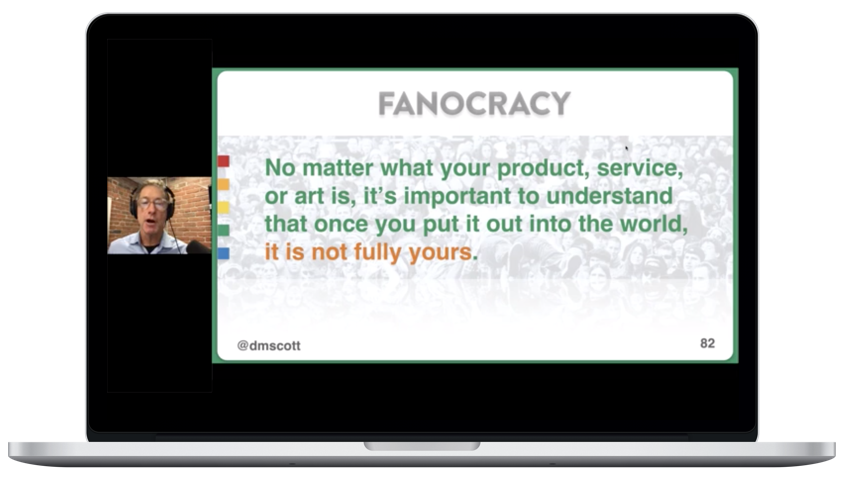Five years ago, I teamed up with my 26-year-old daughter, Reiko, to research and write our recently published book Fanocracy: Turning Fans into Customers and Customers into Fans. Over the past several years leading up to its publication, Reiko and I spoke with neuroscientists to understand what’s going on in our brains when we connect with other people. It turns out that physical proximity – a frequently overlooked dynamic in the digital age – is an essential ingredient of building fans.
This understanding teaches us a simple but powerful way to engage with more people and encourage sincere excitement. A few weeks ago, I had the privilege of joining a webinar with LogMeIn’s in-house expert, Erica Maki, to share several fascinating tips on how to do just that. The following neuroscience concept act as a prescription for hosting more effective webinars that build fans of your business.

Fandom isn’t just for celebrities!
It can be rocket fuel for any business or nonprofit that chooses to focus on inspiring and nurturing true fans. But what is it about being around other people that drives connection? Why does physical proximity make such a difference? Cultural anthropologist Edward T. Hall has answers.
Dr. Hall defined humans’ use of space in a simple way. As director of the State Department’s Point Four Training Program in the 1950s, Dr. Hall’s mission was to teach foreign country-bound technicians and administrators how to communicate effectively across cultural boundaries. His 1966 book The Hidden Dimension describes how people like to keep certain distances between themselves and other people. If we want to be effective in our communications, we need to learn how to consciously manage the physical space between ourselves and others.
It’s not just a matter of being near, or far – or that the closer we get, the better it is. Rather, the significance of each level of proximity can be precisely predicted and managed to create the most optimal outcomes. Hall described “public distance” as more than 12 feet away from others, a distance that lacks any sense of precise interaction among those involved. He identified “social distance” for interactions among acquaintances as being from four feet to 12 feet, “personal distance” for interactions among good friends or family from about a foot and a half to four feet, and anything closer as “intimate distance”.
The degree of human proximity ties to shared emotion and has an enormous effect on how well we do in business.
These basic instincts are powerful, and serve us well in fight-or-flight situations. When we’re physically close to strangers (on a subway, for example), we may find ourselves anxious or weary. Conversely, when we’re physically close to people we trust, a personal connection develops and flourishes. Those who cultivate that closeness are able to establish strong emotional bonds and create fans.
Mirror Neurons and Virtual Proximity
So, you might be thinking: What does physical proximity have to do with webinars?
It turns out that our unconscious brain can respond to what we see as if it’s our own experience – even if it’s on social media, film, or a webinar screen – by means of something called “mirror neurons”. This means we can use virtual proximity to enhance the power of our webinars.
Mirror neurons are a group of cells in the premotor cortex and inferior parietal cortex of our brain. These neurons are fascinating because they not only activate when we perform an action (think: biting into an apple, smiling, or getting near to somebody we enjoy being with) they also fire when we observe somebody else performing the same action! When those around us are happy and smiling, our unconscious brain tells us we’re happy, too.
People unconsciously bond with actors and artists and speakers they see on screens and on stage because of mirror neurons. Mirror neurons also help to explain why we feel that we “know” movie stars and television personalities. Our brain tells us that we’ve been in their personal space because of the feeling of proximity to them as we are seeing them up close on the screen.
The same concepts can be applied to webinars.
Mirroring to Build Fans of Your Webinars
If you can’t get physically close to your customers, how can you facilitate intimacy?
Businesses can use the concept of mirror neurons to build fans by using the video component of GoToWebinar. Specifically, a focus on correct camera placement and how you interact with the camera will make participants feel they are in your personal space through mirror neurons.
Virtual proximity through mirror neurons in webinars can be used to build fans in a number of ways:
- Always use the video feature in GoToWebinar!
- Crop the video so that the webinar presenter appears to be in the viewers’ personal space. Typically, this means placing the camera about four feet away.
- Practice and memorize. This way, when you present, you’re looking directly into the camera as much as possible.
- Adopt a friendly and open-minded approach by imaging the camera is a close personal friend.
- Have an interesting (yet non-distracting) backdrop in the room where you present.
You can develop fans of your webinars today by being in close virtual proximity to others using the video component of GoToWebinar.
Applying this strategy and others in Fanocracy will make your company more likely to dominate your category and win business. And beyond the financial benefits, a fanocracy spreads more joy and inspiration to the world at large.
Missed the webinar?
Don’t sweat it. Watch David’s presentation, “How to Ignore True Customer Passion & Win Lifelong Fans” on-demand on GoToWebinar! You’ll learn:
- How some brands have learned to provide the humanity that attracts passionate fans
- How to create Fandom and turn it into rocket fuel for your business
- Inspiring examples of offbeat and mainstream businesses that have harnessed Fanocracy to win big
- How the act of making business personal is the most powerful business strategy of all
